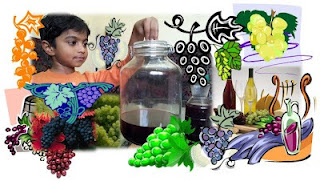VENTEJ® GRAPE WINE RECIPE
(RED, Greenish YELLOW, Dark Pink: varies with what colour grapes are used)
..note: this wine was purely made at my home.. one of my kitchen hobbies.. there is no cut and paste either in this recipe or in any part of this blog site.
Making homemade wine isn't as complicated as it may seem.
Yes, you can do it.!
I have been making grape wine in different flavours and distributing among friends and families for fun..!
and of course more you store, the more tastier it is..!
The basic ground rule in wine making is keeping things clean and sterile. This is to ensure that the brew does not get contaminated with bacteria which may spoil the brew instead of allowing it to ferment.
Ingredients:
|
*
|
Fresh Red Grapes
(2 Kg)
|
 ` `
|
*
|
Sugar (clear white)
(1 Kg for 2Kg grapes) .. if you need more sweeter wine, add more sugar.
|
|
*
|
Beetroot
(medium sized cut to small cubes)
|
|
*
|
Yeast
(2 Teaspoon)
|
|
*
|
Whole Wheat grain
(2 Tablespoon). Wash and clean the grains.
|
|
*
|
Clean and pure Water
(1 Lt)
|
Boiled and cooled.
|
*
|
Salt
2 table spoon
|
To soak and wash the grapes
|
Materials/ Tools Required:
|
*
|
Porcelain jar or Earthen Pot
|
Big enough to store 5 litters (2 kgs grapes + 1 ltr water + 1 kg sugar + 20% free space). Preferably must have a lid.
|
*
|
Wooden pestle / potato masher
|
Will be used to mash grapes.
|
*
|
Long wooden spoon
|
This should be long enough to reach the bottom of wine jar while stirring.
|
*
|
meshed filter
|
|
Steps:
1. Firstly, make sure the jar or the container used for wine making is cleaned well and sanitized. Porcelain jars or earthen pots are ideal and the best. However, for those who cannot find a pot or jar, can go for an air tight bucket too.
2. Boil the water for at least 5 mins. to kill any bacteria or germs in it. Let it cool down. Leave it until room temperature before you can use it.
3. Take a large bowl filled with lukewarm water. Mix with 2 table spoon Salt. Put the bunch of grapes in the bowl. Let it remain soaked for 15 mins. This will kill the worms, germs and dirt if any. Now rinse thoroughly and drain the salty water. Rinse again with clean water and drain water completely. Allow it to dry off the excess water. Now remove the grapes from the bunch one-by-one and put it in the wine jar.
4. Mash the grapes with a potato masher or wooden pestle/ spatula (if you don't have masher just chop it in a mixer-blender). Rupture the grapes. There's no need to remove the skins first.
5. Add sugar to the jar and stir with wooden spoon (preferably) for a couple of mins. No need to dissolve completely. Then add yeast. (better if yeast is prepared by dissolving the yeast powder in lukewarm water). Stir again. [Sugar proportion may be slightly varied depending on individuals taste]
Why wooden spoon? Bacteria grow faster on plastic and metal spoons. Wooden spoons are biodegradable and they tend to be a good shape for stirring!
6. Add wheat grains and beetroot
cubes (The fermentation patterns of beetroot are remarkable and will add natural red colour to your wine. The wheat contains starch which undergo fermentation to give maltose)
7. Fill the remaining space in the wine jar with water (1 lt; as per the measurement mentioned under ingredients). Stir again. A couple of stir will do. Cover the jar with cotton cloth and tight with lid. Now store in dark and dry place.
8. Place the jar in a dark place. 2nd day and there after everyday either morning or evening open the lid carefully and slowly. Stir evenly the contents using wooden spoon. Ensure the spoon is 100% clean and dry every time you stir. Continue this process for 21 days. [If it's winter season 21 days is required. However, for summer season
15days is sufficient for fermentation. There will be no air bubbles on the
top. This indicates that the wine is ready to be strained].
9. On the 22nd day filter the brew: Strain the wine into another container using fine meshed filter. Finally, pour into dark coloured glass bottles (close tightly with a cork; if available) and store it.
The older the stored wines, the better it tastes and stronger it becomes!!
Tips:
i) Sour grapes make sweet wine. 
Wine
colour may vary with different grapes. Beetroot; apart from its
fermentation power will release more reddish colour. If you are using green grape avoid
adding beetroot, this way you get greenish yellow wine. Add the below spices on
day 1 of fermentation if you need added flavour.
ii) Optionally you may add 1 small cinnamon stick  OR 1-2 cardamoms
OR 1-2 cardamoms  OR 1-2 cloves
OR 1-2 cloves for varying flavours..!. For natural grape wine flavour no need to add the above spices. However, if you want to bottle wines in different flavours try adding those spices during the fermentation stage.
for varying flavours..!. For natural grape wine flavour no need to add the above spices. However, if you want to bottle wines in different flavours try adding those spices during the fermentation stage.
iii) To the sieved solution, and before storing into
bottles, add sugar caramel (more sugar means more sweetness) and let it set for
another 2 weeks. Do not open the jar during this period. The sugar caramel
solution is added for extra color and sweetness.
Enjoy drinking something made at home, easier and cheaper.
posting soon.. VENTEJ® GINGER WINE WITH CARAMELIZED SUGAR RECIPE




















